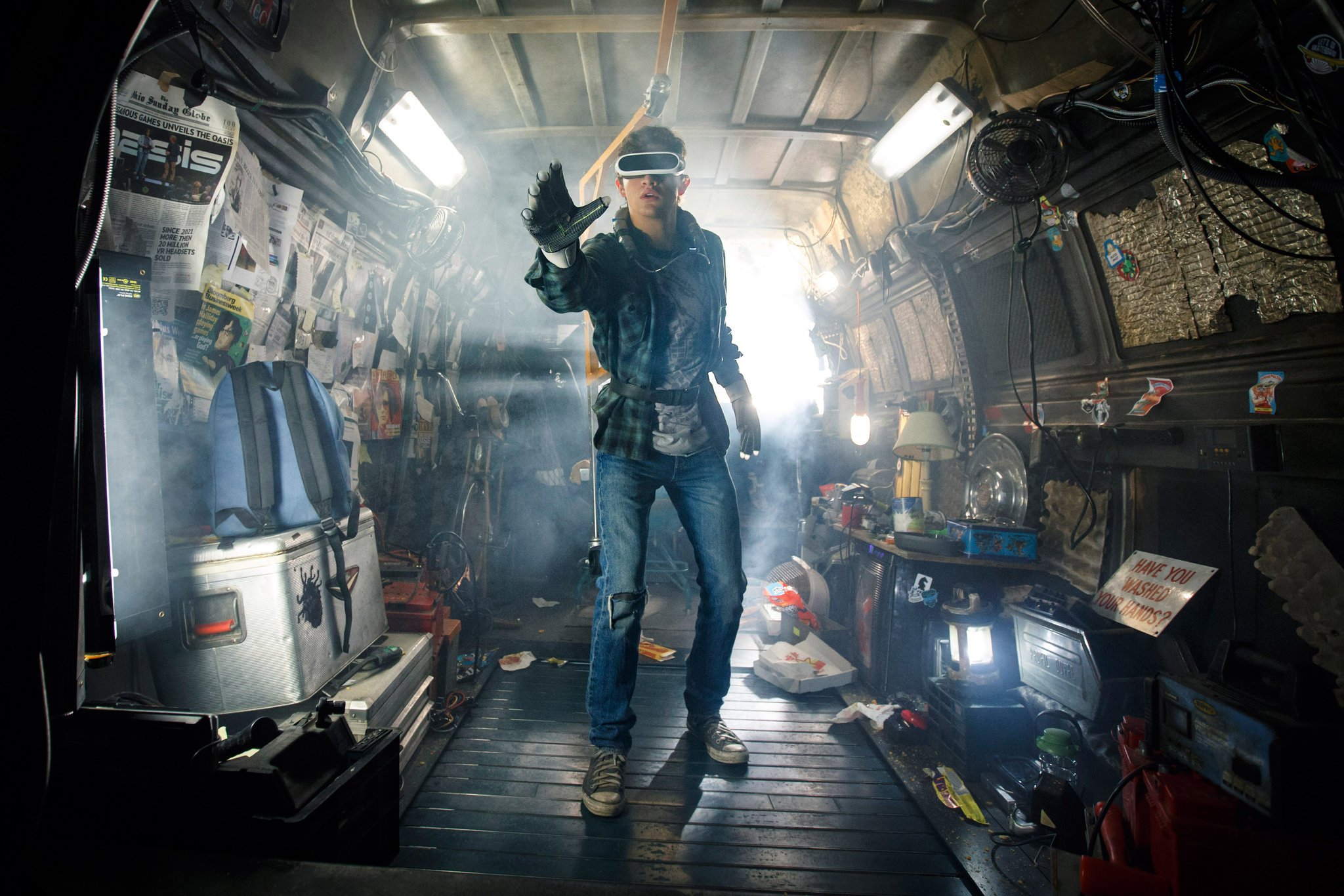‘Ready Player One’ Set to Send Steven Spielberg Back to the Box Office Leader Board and Back to the Future

Up Up iloguown Down Left Right Left Right B A
If you recognize the above sequence or vaguely associated it with Nintendo, then you’ll likely enjoy Ready Player One, the latest sci-fi adventure from Steven Spielberg.
In the year 2045, the real world is unbearable. The only time Wade Watts (Tye Sheridan) can truly feel alive is when he escapes to the OASIS, an immersive virtual universe which allows users to be whoever they wish to be. The late creator of this virtual world had announced a competition – an all-out hunt for the ‘easter egg’ hidden in the OASIS – find three keys, solve three puzzles and the control of the Oasis will be yours. The mad genius behind this universe is James Donavan Halliday (Mark Rylance) whose childhood experiences through the golden age of video games and 80’s entertainment make up the guiding tome that any gunter (“egg hunter”) will need to decipher Halliday’s puzzles before Nolan Sorrento (Ben Mendelsohn)and his company IOI find the egg and bring Halliday’s world under corporate control.
This return to fantastic spectacle for Spielberg has been overdue and highly anticipated since the announcement of his adaptation. Ernest Cline’s novel is an easy one to recommend to fans of ’80s movies, video games, virtual reality, or dystopian future stories. Halliday’s favorite fictional places, and even his own hometown of Middleton, Ohio, have all been painstakingly recreated in the Oasis, allowing for a nonstop cycle of nostalgic references. An early treat in the film involves a street race through New York City with a Delorean being outmaneuvered by Shotaro Kaneda’s motorcycle from Akira while avoiding destruction from Jurassic Park’s Tyrannosaurus Rex and the king himself, Kong. Spielberg himself is responsible for many of these warm memories so it’s no surprise that the film is saturated with references both obvious like King Kong and more subtle like the Zemeckis cube (a Rubik’s cube that when featured, the scene uses the same music cue from the Robert Zemeckis film Back to the Future, produced by Spielberg and scored by Ready Player One’s composer Alan Silvestri). From the earliest trailer to today’s release, we’ll absolutely continue to get more in depth analyses of the references you likely missed like a nearby theatre’s marquee displaying a film starring Jack Slater (Arnold Schwarzenegger’s character in co-writer Zak Penn’s 90’s film Last Action Hero).
What offers some immediate gratification is also cause for the same criticism the source material received – there’s not much beyond the frequent pop culture references. Family Guy has received criticism for its humor relying too heavily on lengthy pop culture referencing non-sequiturs where the enjoyment reserved for actual humor is filled from a feeling of inclusion and recognition of a pop culture reference. An entire recent season of South Park included memberberries, whose main function is to trigger memorable pop culture such as elements from the original Star Wars trilogy (“‘Member Tatooine?”) before eventually making conservative comments about Ronald Reagan, Mexicans or one of their longer lines, “‘Member when marriage was just between a man and a woman?” South Park used the nostalgia of “member when?” as commentary on NFL debates, the 2016 presidential campaign, entertainment reboots of beloved franchises, and the vulnerability of the public to be influenced by false sense of happiness, security or fear.
While the info dumping may be pleasing to fans who catches each reference, the story too easily falls into lazy exposition with enraging dialogue. Exchanges between characters describing the significance of their destination could’ve easily been cut as they repeat their motivation and intentions in the very next scene just to further explain why Halliday opted to include it in the Oasis. In one scene, the plan of action is explicitly explained for the benefit of a tertiary character, briefly standing in for the viewer, but the audience quickly catches up as the scene plays out and is ready to just follow the action, which is repeatedly interrupted with callbacks to prepare for payoff that many already see coming. It’s disappointing when any dialogue in a film be dumbed down solely because it’s catering to children. Children are smarter than they are given credit for. Harry Potter chapter endings may have had spoken summations that reward developing readers and set up cliffhangers, but films geared to “all audiences” should be just that, appropriate for all audiences, not skewed younger. Anyone born in the 80s had probably grown up seeing Back to the Future and Raiders of the Lost Ark dozens of times before they were old enough to fully understand every facet of the story, but the story essentials are still easy to grasp and ride you through to the end. In Ready Player One’s case, it’s perhaps done purposefully in a video game storytelling style, which may be equally insulting to game designers, but it likely should’ve left the in-depth explanations for Cline’s readers rather than Spielberg’s viewers.
Adapting Ernest Cline’s love fest to his 80’s pop culture was always expected to be a daunting task. A book that USA today called “Willy Wonka meets The Matrix” is essentially about songs, TV shows, games and movies. As much discomfort that came from the performances and dialogue, there was possibly more relief at the level of content pared down for the screen adaptation. The quest for the egg involved tests to reach a key, additional avatars, interplanetary travel,, acquired specialty items to advance the gunters’ quests, and a lot of research into Halliday’s most beloved memories leading to seemingly impossible challenges such as a perfect game on Pac-Man or navigating their way through Halliday’s bedroom to play his copy of Dungeons of Daggorath. While the intricacies of how Wade and his friends manage to uncover the tools needed to win, watching someone explore a video game world is unbearable. A very welcome change in the film is taking the Oasis recreation of Dungeons and Dragons’ Tomb of Horrors and replacing it with the more cinematic and fan-pleasing set of The Overlook from Stanley Kubrick’s masterpiece The Shining. The soundtrack and striking images not only evoke visceral emotions and memories for far more than a computer game would, but also is ripe for comic relief when a character unfamiliar with the horror classic unknowingly follows a tennis ball down a hall to ask, “Little girls, you know how to get out of here?” before seeking refuge in Rm. 237.
While these very overt and drawn out references earn the most laughs, (2nd to The Overlook may be a “fucking Chucky” line), perhaps the more rewarding experience was recognizing the hidden gems in nearly every frame – from Back to the Future’s Goldie Wilson mayoral campaign poster pinned to a bedroom wall, to Mad Max’s Ford Falcon V8 Interceptor racing through NYC, to a Battletoad charging towards the climactic battle. It’s these minor but thoughtful placements that feel that much more special knowing that others are not in on the joke. The in-depth passages in Cline’s novel at times may resemble a deep dive into the rabbit hole of geek and nerd culture WikiPedia entries, but the film is weighed down by unrealistic commentary instead of opting for brief references that fly by the oblivious audience member. For example, Wade’s dilemma on what to wear results in multiple characters acknowledging that his outfit is from Buckaroo Banzai, his favorite film. The uninitiated can accept this quick, repeated reference and move on while others may be prompted to later check out the titular polymath’s adventures across the 8th dimension – without having to spend any more running time peacocking to pop culture enthusiasts. A squishy squeeze toy plays a significant role but as it’s never identified by name, Madballs, many viewers may immediately recognize but fail to identify by name and that’s how it should be.
It’s evident that a lot of thought and effort into clearing what intellectual properties went into the virtual world developed as a lovefest to the 70s, 80s and 90s of American media, so it’s odd for a character to comment “old school” when the BeeGee’s 1977 hit “Stayin’ Alive” comes on at a dance club and have it pass the smell test. The Bee Gees are not an obscure or even dated reference for the highest-ranking lady gunter Samatha Evelyn Cook, aka Art3mis (Olivia Cooke). Even though she was born in the 2020’s, her entire life, like many in her world, has sadly been immersed in a virtual world that has consumed the entire internet as well as the lives of most on the planet.
We are presented a world where trivia is scripture. Ernest Cline has managed to use his powers for good and create a fun, albeit poorly written, story, with his pop culture obsessions. Spielberg has managed to create another well-executed fun ride but it doesn’t depart enough from its source material. Its central hero is rewarded for isolating himself from others and dedicating his life to fantasy; there is redemption for some in the film who understand the value of real relationships, missed opportunities and, essentially, a wasted life but it only scratches he surface of what rich science fiction can say about ourselves and our hopes for future. While the nostalgia factor is heavy-handed, it’s really just a device allowing to explore Halliday’s past that raise questions of friendship, success, and the morality of the dreamers who tinkered with tech in their garages. Spielberg pays tribute to his film friends Stanley Kubrick and John Hughes, but he is also a peer of the very innovator that Halliday’s soft-spoken and eccentric style is channeling, Steve Jobs, as well as other tech giants who more closely resemble Sorrento’s IOI corporate villainy. Perhaps no other filmmaker is better suited to balance the creative with the corporate. Spielberg has reached the top of the mainstream box office leaderboard and will never be surpassed, but what is more remarkable is that even his biggest films still have the deeply personal resonance that his smaller pictures do. Ernest Cline’s loved/hated novel was never expected to be deconstructed and rebuilt into a penetrating introspective film, but Slielberg still manages to carve out and shine a light on what makes us human, even if we’ve retreated to our personal screens and VR devices.
Ready Player One exists in a world where beating Super Mario 3 in 5 minutes, accurately quoting Jeff Spicoli, or any impressive display of useless knowledge can save humanity – and that’s pretty fantastic! You won’t need to be able to recite all of Monty Python and the Holy Grail to enjoy Ready Player One, but then again, you should already be able to anyway.
—
Ready Player One
Director Steven Spielberg
Writers Zak Penn, Ernest Cline
Stars Tye Sheridan, Olivia Cooke, Ben Mendelsohn, Lena Weite, T.J. Miller
Rating PG-13
Running Time 2h 20m
Genres Action, Adventure, Sci-Fi
SaveSave

